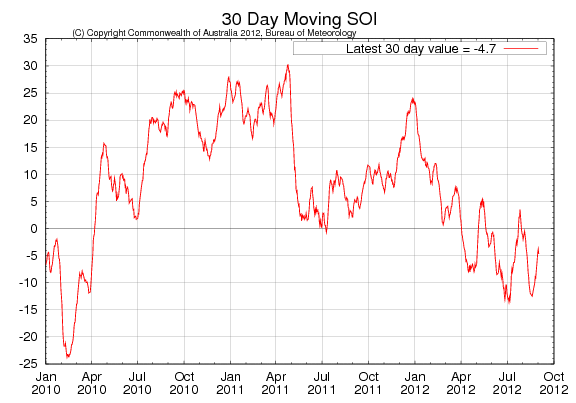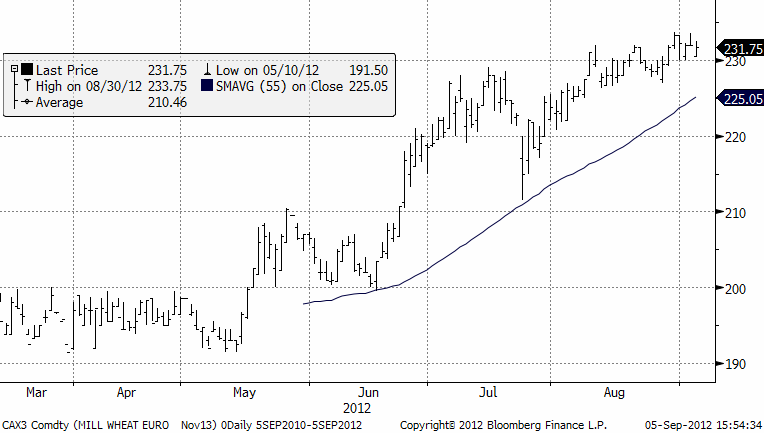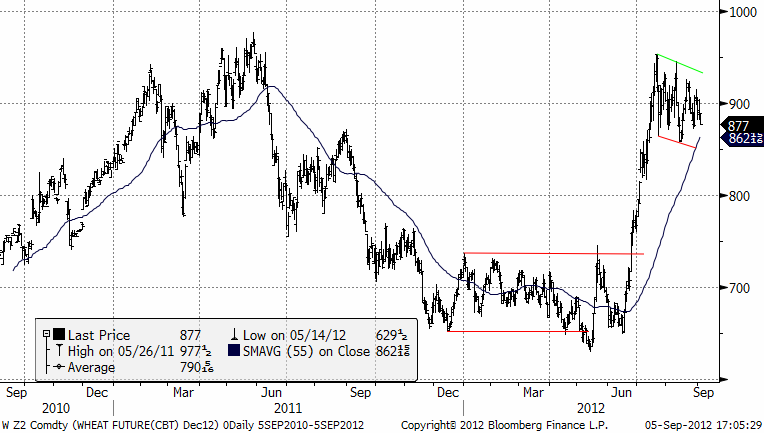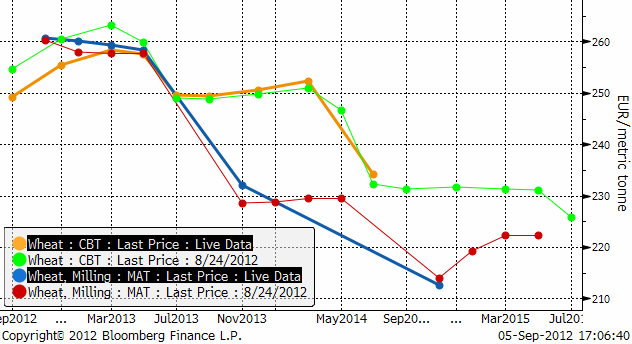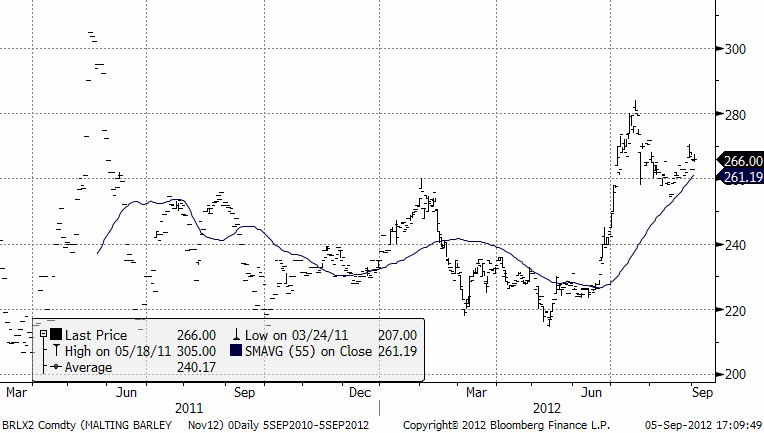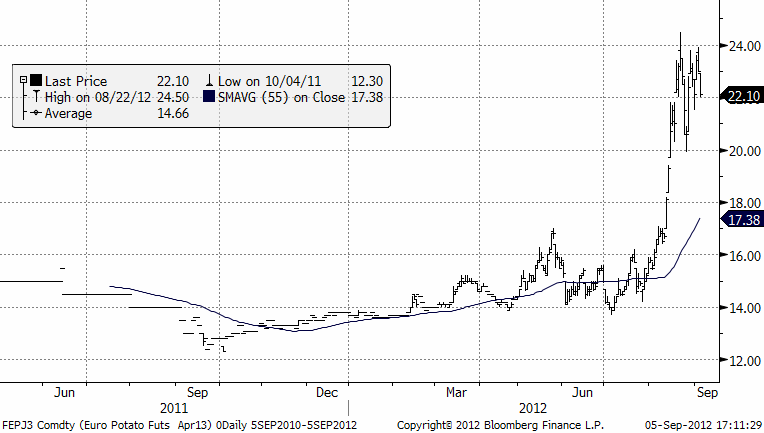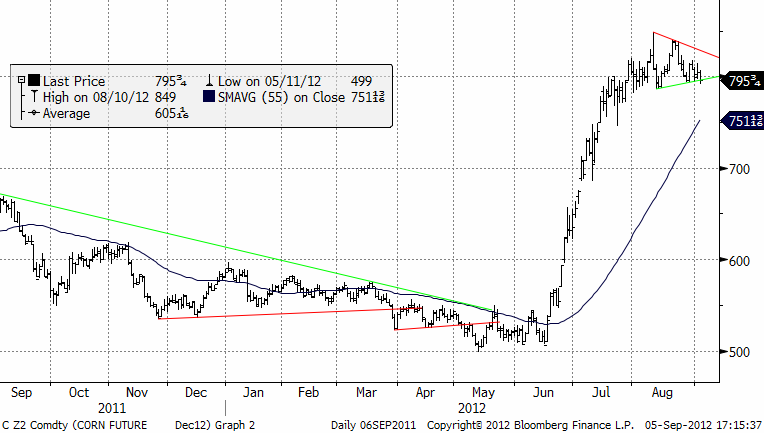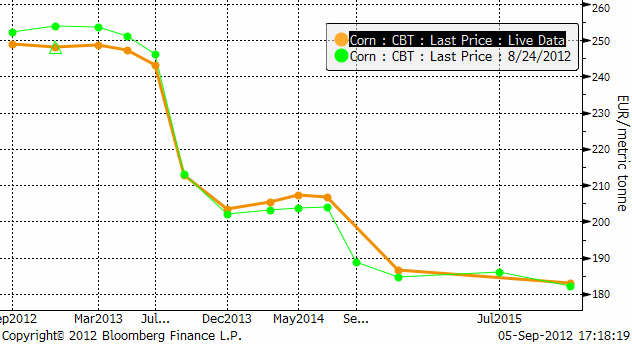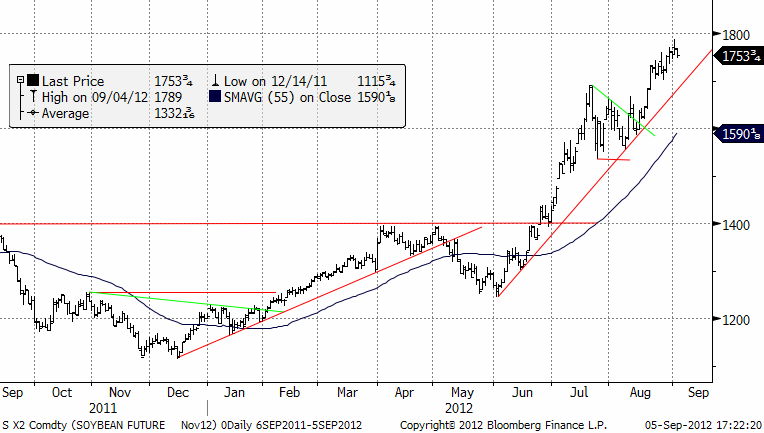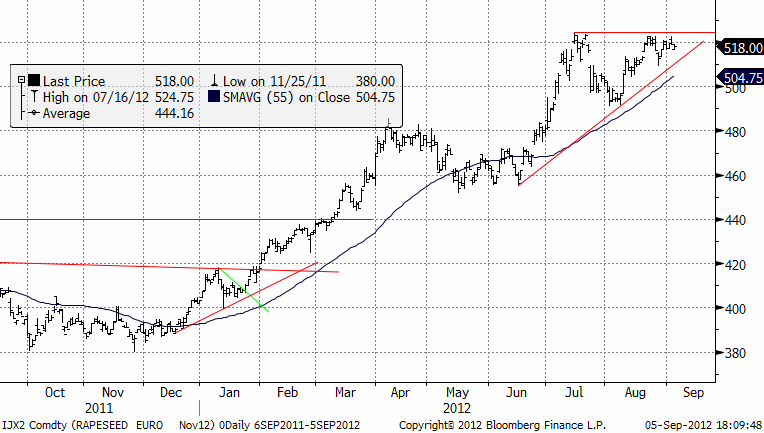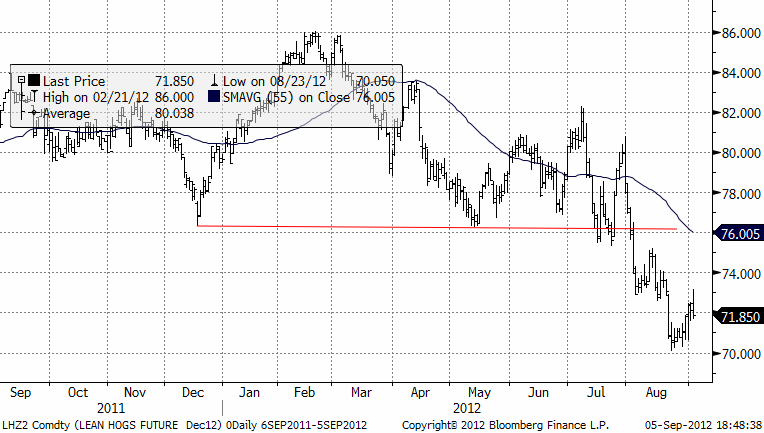Analys
SEB Jordbruksprodukter, 6 september 2012
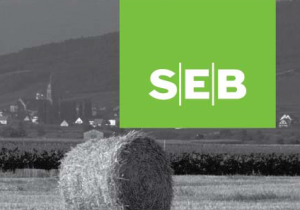 Det har varit en händelsefattig vecka. Priserna har rört sig ”sidledes” till stor del. Nästa vecka släpper USDA WASDE-rapporten för september och det lär vara en flau marknad till dess. Den 4 september meddelade den tyska terminsbörsen EUREX att man startar handel i vasslepulver. Handeln startar den 28 september. Terminskontrakten avser 5 ton, dvs samma storlek som de tidigare terminskontrakten på smör och skummjölkspulver. Underliggande index, som terminerna avräknas kontant mot, är
Det har varit en händelsefattig vecka. Priserna har rört sig ”sidledes” till stor del. Nästa vecka släpper USDA WASDE-rapporten för september och det lär vara en flau marknad till dess. Den 4 september meddelade den tyska terminsbörsen EUREX att man startar handel i vasslepulver. Handeln startar den 28 september. Terminskontrakten avser 5 ton, dvs samma storlek som de tidigare terminskontrakten på smör och skummjölkspulver. Underliggande index, som terminerna avräknas kontant mot, är 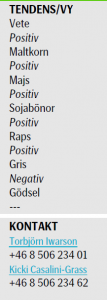 ”European Whey Powder Index”, som publiceras av Agrarmarkt Informations- Gesellschaft GmbH, i Bonn. De befintliga terminskontrakten på smör och skummjölkspulver noterades i maj 2010. Samtidigt ökar nu EUREX antal terminskontrakt som går att handla. Det kommer att finnas terminskontrakt för varje månad de närmaste sex månaderna. Därutöver kommer det att finnas terminskontrakt för varje kvartal med cykeln januari, april, juli och oktober.
”European Whey Powder Index”, som publiceras av Agrarmarkt Informations- Gesellschaft GmbH, i Bonn. De befintliga terminskontrakten på smör och skummjölkspulver noterades i maj 2010. Samtidigt ökar nu EUREX antal terminskontrakt som går att handla. Det kommer att finnas terminskontrakt för varje månad de närmaste sex månaderna. Därutöver kommer det att finnas terminskontrakt för varje kvartal med cykeln januari, april, juli och oktober.
Odlingsväder
ENSO fortsätter att surfa på gränsen till ett riktigt El Niño. SOI ligger nu på -4.7, men låg förra veckan på – 9.1. Gränsen för El Niño ligger på -8. Klimatmodeller prognostiserar att ENSO kommer att fortsätta ligga på gränsen fram till slutet av året eller in i början på 2013, för att sedan återgå till normala ENSO-förhållanden.
Kanada är helt utan nederbörd den här veckan och skörden fortskrider snabbt. Europa har också varmare och torrare väder än normalt – utom här i norra Europa. Kina har just fått en tyfon, förra veckan och har fått mer regn än normalt. Monsunen i Indien fortsätter att förbättras. Indien har nu skörd nummer två på gång och den gynnas. Vi skrev förra veckan att den förbättrade monsunen har fått läget att ljusna för grödor som majs, ris och sojabönor. Arealen sådd med ris har ökat till 32.9 miljoner hektar från 30.8 förra året. Förra årets skörd var rekordhöga 91.5 mt, enligt det indiska jordbruksministeriet.
Argentina har god nederbörd över alla väsentliga odlingsområden. Parana i södra Brasilien, där vete odlas, har också fått del av den här nederbörden. Däremot är det torrt i typiska sojaområden i centrala och norra Brasilien. Region Centro-Oeste har fått 50% av normal nederbörd. Nedanför ser vi en ögonblicksbild av vädret där.
Med utsikter om att El Niño blir ganska mild, alltså med ett ENSO som ligger på ”nästan” El Niño, kan nederbörden i Brasilien och Argentina bli mindre än vad vi trodde under våren, när det såg ut att bli en starkare El Niño. Australien har ytterst lite nederbörd – vilket är i enlighet med vad som vanligtvis sker vid ett El Niño.
Vete
Tekniskt har Matif:s novemberkontrakt fortsatt att röra sig ”sidledes” och vi tror fortfarande att nästa större rörelse blir uppåt. Den som vill ta en position redan nu, köper terminen och lägger en stop-lossorder på 258 euro. Den som placerar på lite längre sikt kan lägga stoppen på 253.90. Kursen ligger i skrivande stund på 261.50.
Det börjar ju dra ihop sig till att byta år, och då kan det vara bra att se kursutvecklingen för Matifs november 2013-kontrakt. (Kan kanske också vara ett lämpligt tillfälle att börja handla hos SEB?) Priset för nästa års skörd har som vi ser inte rört sig sidledes som november 2012, utan segat sig uppåt.
Nedan ser vi Chicagovetet med leverans i december. Den tekniska bilden indikerar samma sak här – förestående brott uppåt (förmodligen).
I diagrammet nedan ser vi terminspriserna framåt i tiden för Chicago och Matif och förändringen från 7 dagar sedan. Vi ser att backwardation har minskat i USA. Priset för leverans nästa november (2013) är nästan 20 euro per ton högre i Chicago än i Paris. Förra veckan var det 20 euro. Nu har skillnaden minskat ett par euro.
Nedan ser vi medias intresse för nyckelorden Wheat+Export+Ban. Som vi ser lite mindre intresse och också lite lägre priser. Frågan om exportstopp i Ryssland har mycket stor effekt på priset i den oroliga situation som nu råder.
Det ryska jordbruksministeriet har uppdaterat hektarskördeestimaten och de visar att hektarskörden för vete är 32% lägre än förra året. Det innebär en skörd av vete på ca 38 mt. Hektarskörden för spannmål inklusive majs är, enligt det ryska jordbruksministeriet, 27% lägre än förra året. Minns att vi i det här brevet för ca en månad sedan gjorde kalkylen 94 x 0.7 = 66 mt. 94 mt var förra årets skörd. 27% lägre skörd blir 68.6 mt. Detta är lägre än vad ministermötet i fredags resulterade i, en sänkning från 75 mt till 70. Vi har skrivit att vi tror att 70 mt är en allt för optimistisk siffra och att den kommer att följas av ytterligare nedjusteringar vid följande ministermöten. Samtidigt sänks exportpotentialen, tror vi. Det kommer en GASC-tender för novemberleverans. Om de accepterar några erbjudanden på ryskt vete eller inte, kommer att säga en hel del om hur det egentligen står till med rysk export. Sådden av höstvete i Ryssland rapporterades vara avklarad till 15%.
Vi nämnde under ”odlingsväder” att El Niño gör det torrt i Australien. Västra Australien har fått ungefär hälften av normal nederbörd. Vetet sätter ax just nu och börjar skördas i oktober. Så lite regn är naturligtvis inte bra för skördens storlek. Vi har även vad gäller Australien gjort egna El Niño-baserade beräkningar och kommit fram till att skörden ”borde” bli lägre än de 26 mt som USDA förutspådde i senaste WASDE-rapporten. Det ”borde” komma en nedjustering i WASDE-rapporten nästa vecka.
Maltkorn
Novemberkontraktet på maltkorn har funnit stöd och ser ur teknisk synvinkel ut att kunna stiga den närmaste tiden. Det är samma vy som förra veckan. Ingen förändring.
Potatis
Potatispriset tycks stabilisera sig mellan 20 och 24 euro per deciton. Det återstår att se om det är en konsolidering inför ytterligare prisuppgång över 24 euro, eller en toppformation i väntan på att se vad som händer med konsumtionen.
Majs
Vi skrev förra veckan, att ett brott nedåt inte skulle vara bra och skulle innebära att vi skulle gå ur alla positioner och rentav kanske gå kort. Nu har priset faktiskt i skrivande stund gått under stödlinjen i triangelformationen och det är en klart negativ signal.
Nedan ser vi terminskurvan framåt i tiden för majs. Vi ser att de korta kontrakten har fallit. De längre har stigit.
Måndagens crop ratings för majs var kom in med 22% i good/excellent condition, vilket är på samma nivå som förra veckan. 41% är moget. Förra året så här års var det bara 15% som var moget. 10% är skördat. Förra året var det 3%.
Sojabönor
Priset steg som väntat upp från den lilla konsolideringen i veckan som gått sedan förra veckobrevet. Den teoretiska målkursen enligt skolboken i teknisk analys ligger på 1879 cent / bu. Uppgången verkar förlora kraft och övertygelse, vilket är naturligt när det börjar närma sig målkursen. Trenden uppåt är bruten, men det är möjligt att det kommer in mer säljare vid de här nivåerna på 1800 cent.
Crop conditions var oförändrade från förra veckan. 30% är i good eller very good condition, med 38% är i poor eller very poor condition. 9% har tappat löven; det är långt över genomsnittet för de senaste fem åren, som ligger på 5%.
Brasiliens skörd ligger åtskilliga månader framåt i tiden och när det nu är torrare än normalt i sojadistrikten, framförallt i region Centro-Oeste, kan vädret där få en stor effekt. Det är viktigt att det regnar i september och framförallt i oktober för att det ska bli en god skörd. Världen behöver en rekordskörd från Brasilien efter årets missväxt i USA.
Raps
Ett brott uppåt rycker allt närmare, när trycket ökar i marknaden. Att det finns övertygade säljare på 520- nivån är dock helt klart och det kan också komma ett brott nedåt. Nästa stöd finns då på 490 euro. Man kan fortsätta ligga lång (osäkrad) och behålla en stop-loss-order på en nivå under 55-dagars glidande medelvärde. Det är det medelvärde som är inritat i nedanstående diagram.
Gris
Grispriset befinner sig i en tydlig bear market. Men tycks ha kommit till en konsolideringsfas. 70 cent per pund ser ut att vara golvet på konsolideringsområdet.
Mjölk
Priset på mjölkpulver i Nordeuropa ligger på samma prisnivå som förra veckan. Det är den första veckan sedan juli när priset inte har stigit. Priset på smör har däremot gått upp från 3150 euro per ton till 3300 euro per ton.
Nedan ser vi priset på smör, också oktoberkontraktet såsom handlat på EUREX. Priset är angivet i euro per ton.
På den amerikanska börsen CME i Chicago har priset faktiskt gått ner något för decemberleverans, som vi ser i diagrammet nedan. Priset har ändå gått upp med nästan 30% sedan bottenoteringen i maj månad.
Vad säger då marknaden just nu om priserna för leverans av mjölk i USA i framtiden? Nedan ser vi terminspriserna som kurva som de ser ut idag och hur de såg ut för 7 dagar sedan.
Vi rapporterade även i inledningen av brevet att EUREX noterar terminskontrakt på vasslepulver nu i september. Det händer onekligen mycket på mjölkmarknaden just nu.
Socker
Priset på socker, som handlades ett tag kring 20 cent, började i måndags falla igen. Det ser ut som om bottennoteringen på 18.86 cent som noterades den 4 juni ska testas igen.
EURSEK
EURSEK fortsatte som vi trodde förra veckan upp mot 8.50. Prisuppgången har fått mer och mer kraft. Kanske kommer den här uppgången att gå ända till 8.55 kr per euro.
USDSEK
Dollarn har svarat på supportområdet och hoppat upp från det. Stödet ligger vid 6.60 kr. Priset kan i första hand gå upp till 6.80. Kraften i uppgången tyder på att det kan komma en lite kraftigare uppgångsfas.
[box]SEB Veckobrev Jordbruksprodukter är producerat av SEB Merchant Banking och publiceras i samarbete och med tillstånd på Råvarumarknaden.se[/box]
Disclaimer
The information in this document has been compiled by SEB Merchant Banking, a division within Skandinaviska Enskilda Banken AB (publ) (“SEB”).
Opinions contained in this report represent the bank’s present opinion only and are subject to change without notice. All information contained in this report has been compiled in good faith from sources believed to be reliable. However, no representation or warranty, expressed or implied, is made with respect to the completeness or accuracy of its contents and the information is not to be relied upon as authoritative. Anyone considering taking actions based upon the content of this document is urged to base his or her investment decisions upon such investigations as he or she deems necessary. This document is being provided as information only, and no specific actions are being solicited as a result of it; to the extent permitted by law, no liability whatsoever is accepted for any direct or consequential loss arising from use of this document or its contents.
About SEB
SEB is a public company incorporated in Stockholm, Sweden, with limited liability. It is a participant at major Nordic and other European Regulated Markets and Multilateral Trading Facilities (as well as some non-European equivalent markets) for trading in financial instruments, such as markets operated by NASDAQ OMX, NYSE Euronext, London Stock Exchange, Deutsche Börse, Swiss Exchanges, Turquoise and Chi-X. SEB is authorized and regulated by Finansinspektionen in Sweden; it is authorized and subject to limited regulation by the Financial Services Authority for the conduct of designated investment business in the UK, and is subject to the provisions of relevant regulators in all other jurisdictions where SEB conducts operations. SEB Merchant Banking. All rights reserved.
Analys
The Mid-East anchor dragging crude oil lower

When it starts to move lower it moves rather quickly. Gaza, China, IEA. Brent crude is down 2.1% today to $62/b after having traded as high as $66.58/b last Thursday and above $70/b in late September. The sell-off follows the truce/peace in Gaze, a flareup in US-China trade and yet another bearish oil outlook from the IEA.

A lasting peace in Gaze could drive crude oil at sea to onshore stocks. A lasting peace in Gaza would probably calm down the Houthis and thus allow more normal shipments of crude oil to sail through the Suez Canal, the Red Sea and out through the Bab-el-Mandeb Strait. Crude oil at sea has risen from 48 mb in April to now 91 mb versus a pre-Covid normal of about 50-60 mb. The rise to 91 mb is probably the result of crude sailing around Africa to be shot to pieces by the Houthis. If sailings were to normalize through the Suez Canal, then it could free up some 40 mb in transit at sea moving onshore into stocks.
The US-China trade conflict is of course bearish for demand if it continues.
Bearish IEA yet again. Getting closer to 2026. Credibility rises. We expect OPEC to cut end of 2025. The bearish monthly report from the IEA is what it is, but the closer we get to 2026, the more likely the IEA is of being ball-park right in its outlook. In its monthly report today the IEA estimates that the need for crude oil from OPEC in 2026 will be 25.4 mb/d versus production by the group in September of 29.1 mb/d. The group thus needs to do some serious cutting at the end of 2025 if it wants to keep the market balanced and avoid inventories from skyrocketing. Given that IEA is correct that is. We do however expect OPEC to implement cuts to avoid a large increase in inventories in Q1-26. The group will probably revert to cuts either at its early December meeting when they discuss production for January or in early January when they discuss production for February. The oil price will likely head yet lower until the group reverts to cuts.
Dubai: The Mid-East anchor dragging crude oil lower. Surplus emerging in Mid-East pricing. Crude oil prices held surprisingly strong all through the summer. A sign and a key source of that strength came from the strength in the front-end backwardation of the Dubai crude oil curve. It held out strong from mid-June and all until late September with an average 1-3mth time-spread premium of $1.8/b from mid-June to end of September. The 1-3mth time-spreads for Brent and WTI however were in steady deterioration from late June while their flat prices probably were held up by the strength coming from the Persian Gulf. Then in late September the strength in the Dubai curve suddenly collapsed. Since the start of October it has been weaker than both the Brent and the WTI curves. The Dubai 1-3mth time-spread now only stands at $0.25/b. The Middle East is now exporting more as it is producing more and also consuming less following elevated summer crude burn for power (Aircon) etc.
The only bear-element missing is a sudden and solid rise in OECD stocks. The only thing that is missing for the bear-case everyone have been waiting for is a solid, visible rise in OECD stocks in general and US oil stocks specifically. So watch out for US API indications tomorrow and official US oil inventories on Thursday.
No sign of any kind of fire-sale of oil from Saudi Arabia yet. To what we can see, Saudi Arabia is not at all struggling to sell its oil. It only lowered its Official Selling Prices (OSPs) to Asia marginally for November. A surplus market + Saudi determination to sell its oil to the market would normally lead to a sharp lowering of Saudi OSPs to Asia. Not yet at least and not for November.
The 5yr contract close to fixed at $68/b. Of importance with respect to how far down oil can/will go. When the oil market moves into a surplus then the spot price starts to trade in a large discount to the 5yr contract. Typically $10-15/b below the 5yr contract on average in bear-years (2009, 2015, 2016, 2020). But the 5yr contract is usually pulled lower as well thus making this approach a moving target. But the 5yr contract price has now been rock solidly been pegged to $68/b since 2022. And in the 2022 bull-year (Brent spot average $99/b), the 5yr contract only went to $72/b on average. If we assume that the same goes for the downside and that 2026 is a bear-year then the 5yr goes to $64/b while the spot is trading at a $10-15/b discount to that. That would imply an average spot price next year of $49-54/b. But that is if OPEC doesn’t revert to cuts and instead keeps production flowing. We think OPEC(+) will trim/cut production as needed into 2026 to prevent a huge build-up in global oil stocks and a crash in prices. But for now we are still heading lower. Into the $50ies/b.
Analys
More weakness and lower price levels ahead, but the world won’t drown in oil in 2026

Some rebound but not much. Brent crude rebounded 1.5% yesterday to $65.47/b. This morning it is inching 0.2% up to $65.6/b. The lowest close last week was on Thursday at $64.11/b.

The curve structure is almost as week as it was before the weekend. The rebound we now have gotten post the message from OPEC+ over the weekend is to a large degree a rebound along the curve rather than much strengthening at the front-end of the curve. That part of the curve structure is almost as weak as it was last Thursday.
We are still on a weakening path. The message from OPEC+ over the weekend was we are still on a weakening path with rising supply from the group. It is just not as rapidly weakening as was feared ahead of the weekend when a quota hike of 500 kb/d/mth for November was discussed.
The Brent curve is on its way to full contango with Brent dipping into the $50ies/b. Thus the ongoing weakening we have had in the crude curve since the start of the year, and especially since early June, will continue until the Brent crude oil forward curve is in full contango along with visibly rising US and OECD oil inventories. The front-month Brent contract will then flip down towards the $60/b-line and below into the $50ies/b.
At what point will OPEC+ turn to cuts? The big question then becomes: When will OPEC+ turn around to make some cuts? At what (price) point will they choose to stabilize the market? Because for sure they will. Higher oil inventories, some more shedding of drilling rigs in US shale and Brent into the 50ies somewhere is probably where the group will step in.
There is nothing we have seen from the group so far which indicates that they will close their eyes, let the world drown in oil and the oil price crash to $40/b or below.
The message from OPEC+ is also about balance and stability. The world won’t drown in oil in 2026. The message from the group as far as we manage to interpret it is twofold: 1) Taking back market share which requires a lower price for non-OPEC+ to back off a bit, and 2) Oil market stability and balance. It is not just about 1. Thus fretting about how we are all going to drown in oil in 2026 is totally off the mark by just focusing on point 1.
When to buy cal 2026? Before Christmas when Brent hits $55/b and before OPEC+ holds its last meeting of the year which is likely to be in early December.
Brent crude oil prices have rebounded a bit along the forward curve. Not much strengthening in the structure of the curve. The front-end backwardation is not much stronger today than on its weakest level so far this year which was on Thursday last week.
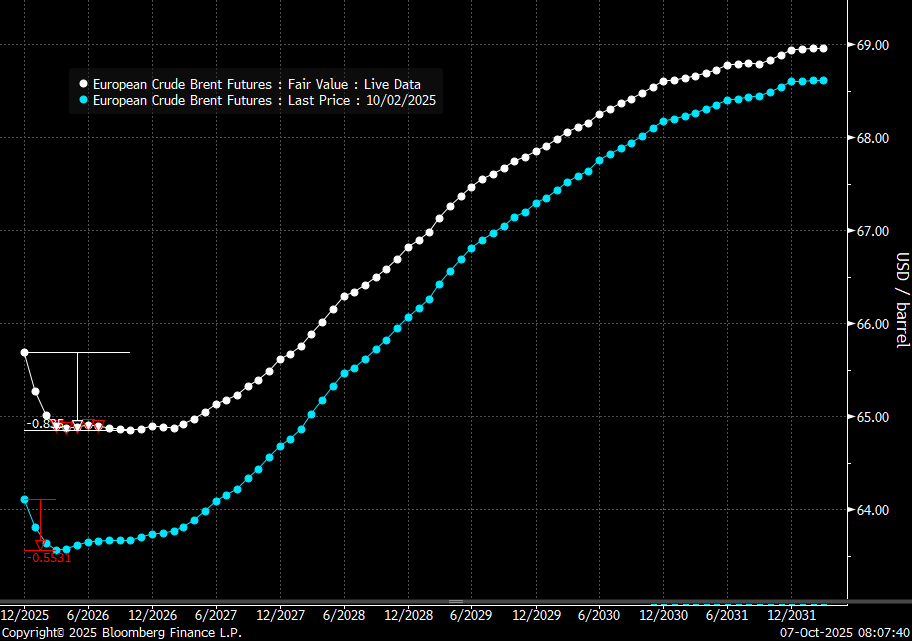
The front-end backwardation fell to its weakest level so far this year on Thursday last week. A slight pickup yesterday and today, but still very close to the weakest year to date. More oil from OPEC+ in the coming months and softer demand and rising inventories. We are heading for yet softer levels.

Analys
A sharp weakening at the core of the oil market: The Dubai curve

Down to the lowest since early May. Brent crude has fallen sharply the latest four days. It closed at USD 64.11/b yesterday which is the lowest since early May. It is staging a 1.3% rebound this morning along with gains in both equities and industrial metals with an added touch of support from a softer USD on top.

What stands out the most to us this week is the collapse in the Dubai one to three months time-spread.
Dubai is medium sour crude. OPEC+ is in general medium sour crude production. Asian refineries are predominantly designed to process medium sour crude. So Dubai is the real measure of the balance between OPEC+ holding back or not versus Asian oil demand for consumption and stock building.
A sharp weakening of the front-end of the Dubai curve. The front-end of the Dubai crude curve has been holding out very solidly throughout this summer while the front-end of the Brent and WTI curves have been steadily softening. But the strength in the Dubai curve in our view was carrying the crude oil market in general. A source of strength in the crude oil market. The core of the strength.
The now finally sharp decline of the front-end of the Dubai crude curve is thus a strong shift. Weakness in the Dubai crude marker is weakness in the core of the oil market. The core which has helped to hold the oil market elevated.
Facts supports the weakening. Add in facts of Iraq lifting production from Kurdistan through Turkey. Saudi Arabia lifting production to 10 mb/d in September (normal production level) and lifting exports as well as domestic demand for oil for power for air con is fading along with summer heat. Add also in counter seasonal rise in US crude and product stocks last week. US oil stocks usually decline by 1.3 mb/week this time of year. Last week they instead rose 6.4 mb/week (+7.2 mb if including SPR). Total US commercial oil stocks are now only 2.1 mb below the 2015-19 seasonal average. US oil stocks normally decline from now to Christmas. If they instead continue to rise, then it will be strongly counter seasonal rise and will create a very strong bearish pressure on oil prices.
Will OPEC+ lift its voluntary quotas by zero, 137 kb/d, 500 kb/d or 1.5 mb/d? On Sunday of course OPEC+ will decide on how much to unwind of the remaining 1.5 mb/d of voluntary quotas for November. Will it be 137 kb/d yet again as for October? Will it be 500 kb/d as was talked about earlier this week? Or will it be a full unwind in one go of 1.5 mb/d? We think most likely now it will be at least 500 kb/d and possibly a full unwind. We discussed this in a not earlier this week: ”500 kb/d of voluntary quotas in October. But a full unwind of 1.5 mb/d”
The strength in the front-end of the Dubai curve held out through summer while Brent and WTI curve structures weakened steadily. That core strength helped to keep flat crude oil prices elevated close to the 70-line. Now also the Dubai curve has given in.
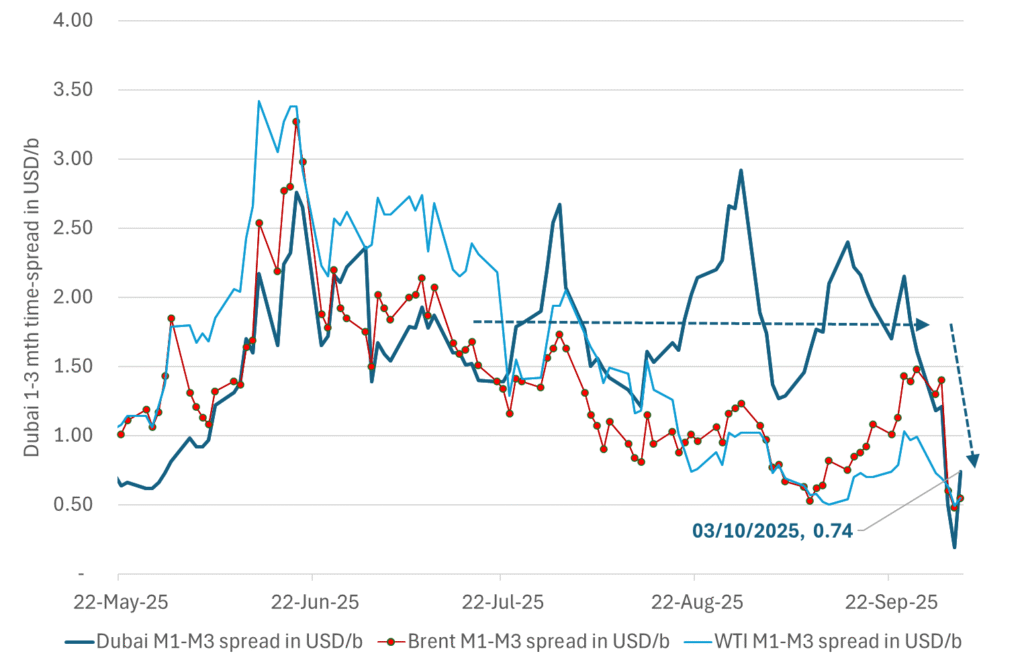
Brent crude oil forward curves
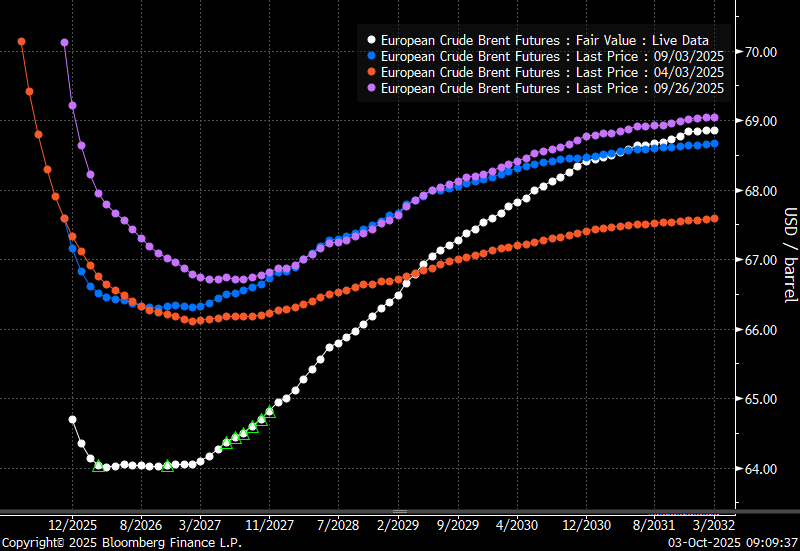
Total US commercial stocks now close to normal. Counter seasonal rise last week. Rest of year?
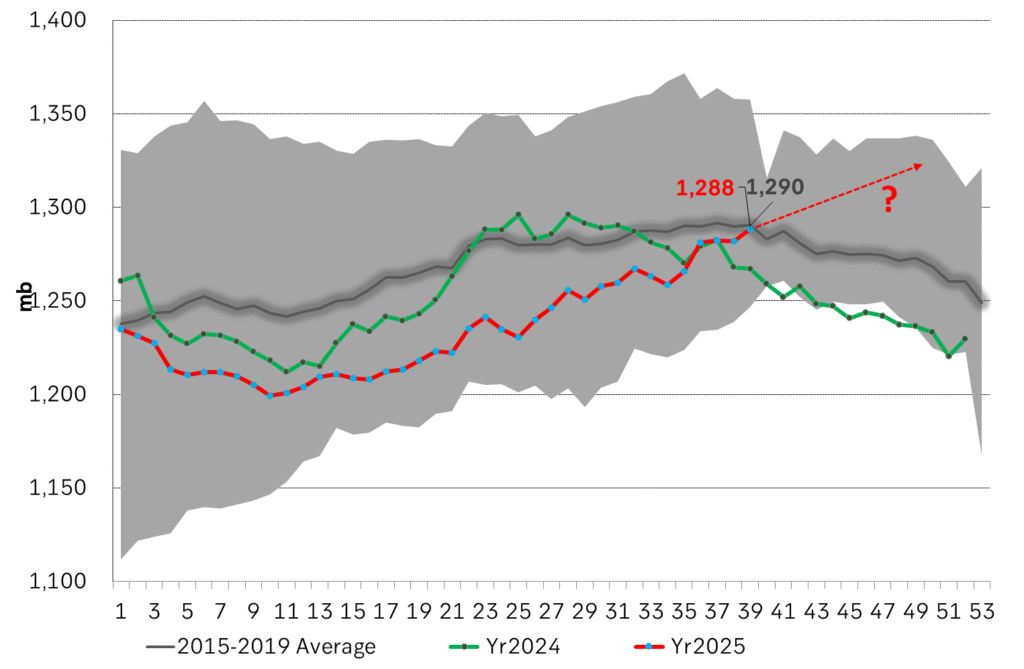
Total US crude and product stocks on a steady trend higher.
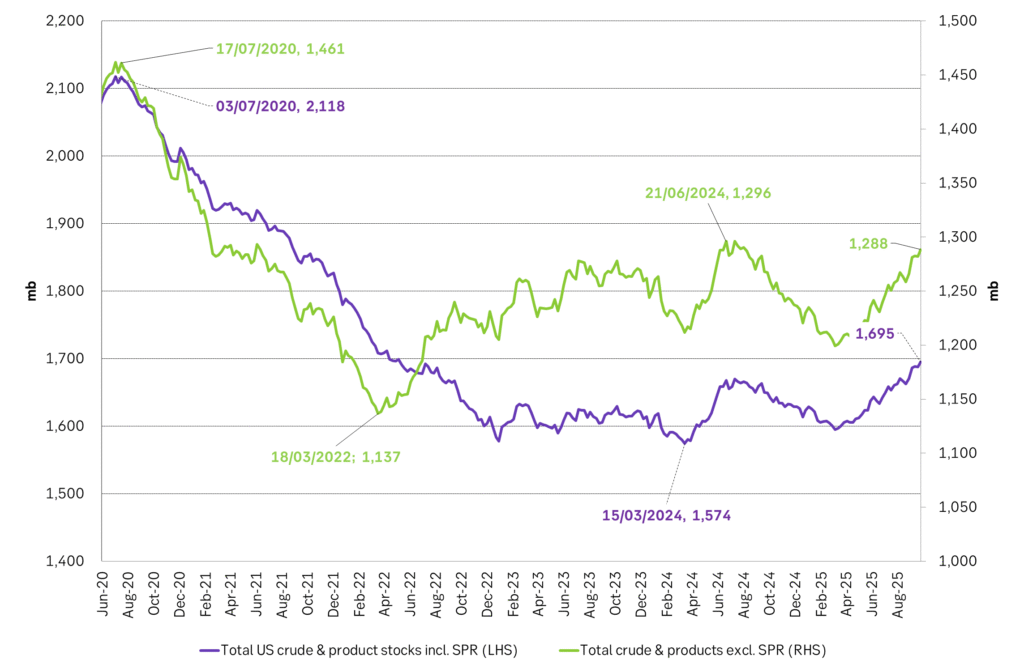
-

 Nyheter4 veckor sedan
Nyheter4 veckor sedanKinas elproduktion slog nytt rekord i augusti, vilket även kolkraft gjorde
-

 Nyheter4 veckor sedan
Nyheter4 veckor sedanTyskland har så höga elpriser att företag inte har råd att använda elektricitet
-
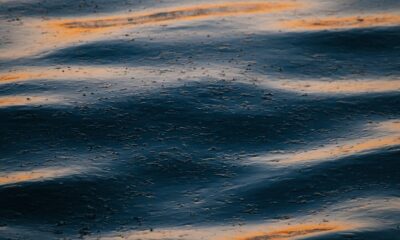
 Nyheter3 veckor sedan
Nyheter3 veckor sedanOPEC+ missar produktionsmål, stöder oljepriserna
-

 Nyheter3 veckor sedan
Nyheter3 veckor sedanEtt samtal om guld, olja, fjärrvärme och förnybar energi
-

 Analys4 veckor sedan
Analys4 veckor sedanBrent crude ticks higher on tension, but market structure stays soft
-

 Analys3 veckor sedan
Analys3 veckor sedanAre Ukraine’s attacks on Russian energy infrastructure working?
-
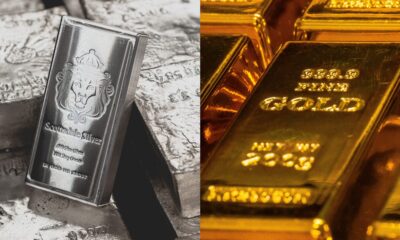
 Nyheter2 veckor sedan
Nyheter2 veckor sedanGuld nära 4000 USD och silver 50 USD, därför kan de fortsätta stiga
-

 Nyheter3 veckor sedan
Nyheter3 veckor sedanGuldpriset uppe på nya höjder, nu 3750 USD


